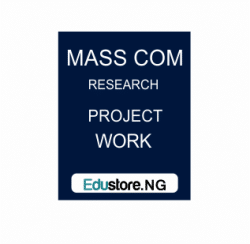CHAPTER ONE
Unlike in the past, the people of the world are today living in a global village as a result of various breakthroughs in information technology.
Information that used to take many days or weeks to disseminate now takes seconds or minutes.
It is now possible for people including professional communicators, public officers and others to get desired information as quickly as possible from other parts of the country or from other countries with the coming of the G.S.M without leaving their immediate environment. We now live in an information age, which means that it is possible and easy to get in touch with relatives and friends all over the world.
In the recent discourses of “The Information Age”, the mobility of individuals and of populations, capital, industry and information is considered critical to the formation of information elites and information societies (Cairncross; Castells). From these discourses a dominant view has emerged in which the digital mobility of information was considered as an essential and informing element of globalisation. It was also widely regarded as a development which would revolutionise news and information production and delivery. This view stemmed from an understanding that media information ‘flows’ as central nodes in social and economic networks are dependent on technology that provides fast, economical transport of information, which can be easily reproduced for mass distribution. Certainly, the news industry has a history of being an early-adopter of forms of technology that provide improvements in the capacity to produce, deliver and sell news and information, one of which in recent times is the GSM. The reporting of news remains an essential element of information transmission, including and especially the reporting of all forms of traumatic events – from major disasters, to isolated incidents. To understand how new mobile technologies (GSM) can both assist and damage journalists reporting on traumatic events, it is necessary to recognise the word “GSM” (i.e. Global System for Mobile Communication), which will be discussed in full in subsequent chapters.
The use of all forms of communication technology has been and remains a critical factor in the transmission of such news, which workers in the media ‘industry’, especially journalists, are required to use routinely. Journalism Historian, Hanno Hardt argues that “for over a hundred years newsrooms, like factory floors, have been a laboratory for technological innovations and a battleground of economic and social interests (173). Earlier still, Schudson proposed that this “technological argument” was a causative factor in an earlier “revolution” from the 1830s in industrialised nations, which produced the model of modern journalism, now challenged by new communications technology. Among these newer developments is the increasing mobility of information, which lighter, cheaper, more flexible technology such as mobile phones, digital cameras and laptop computers allow, together with access to the Internet are most influential.
STATEMENT OF THE PROBLEM
This study is aimed at examining the contributions of G.S.M phones on the news coverage in our society, its nature, its dimensions, functions and uses of the society at large.
It further aims to examine how the G.S.M phone has helped individuals, business organizations and the international communities to communicate quickly and easily.
- For Reference Only: Materials are for research, citation, and idea generation purposes and not for submission as your original final year project work.
- Avoid Plagiarism: Do not copy or submit this content as your own project. Doing so may result in academic consequences.
- Use as a Framework: This complete project research material should guide the development of your own final year project work.
- Academic Access: This platform is designed to reduce the stress of visiting school libraries by providing easy access to research materials.
- Institutional Support: Tertiary institutions encourage the review of previous academic works such as journals and theses.
- Open Education: The site is maintained through paid subscriptions to continue offering open access educational resources.



